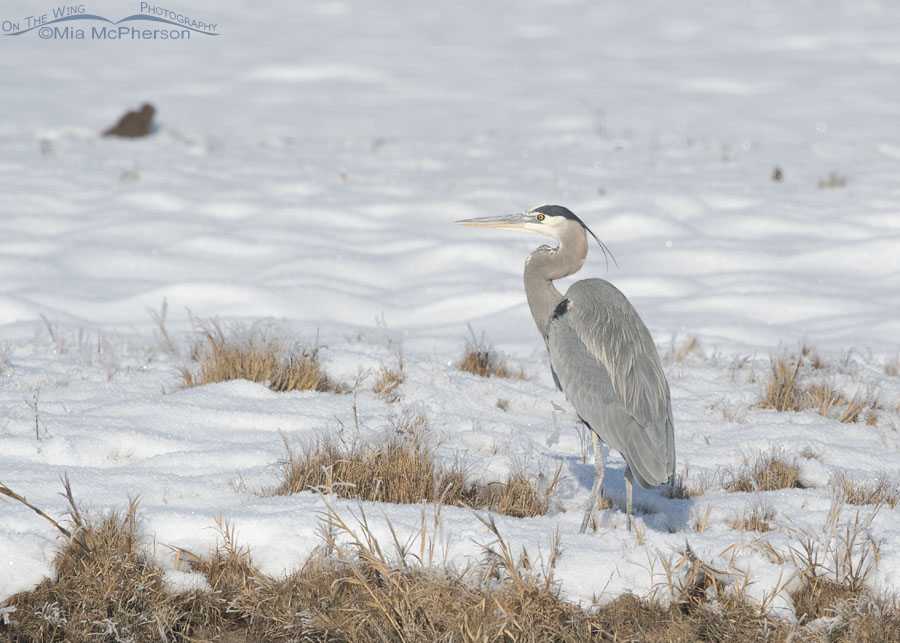 Great Blue Heron photographed on the Winter Solstice – Nikon D500, f7.1, 1/6400, ISO 800, Nikkor 500mm VR with 1.4x TC, natural light
Great Blue Heron photographed on the Winter Solstice – Nikon D500, f7.1, 1/6400, ISO 800, Nikkor 500mm VR with 1.4x TC, natural light
To my delight I was able to take Great Blue Heron photos yesterday on the Winter Solstice that I found on the banks of the Bear River at Bear River Migratory Bird Refuge. After pointing out the first heron I settled in to take photos of it standing on the riverbank in the snow. There was something different about the first heron that is barely visible in this first image.
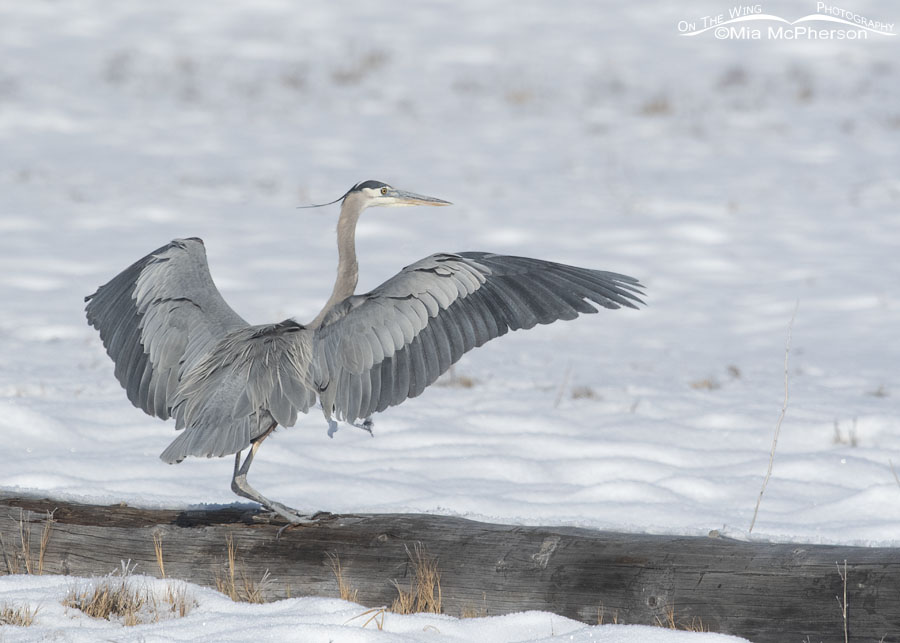 Winter Great Blue Heron landing on a log – Nikon D500, f7.1, 1/8000, ISO 800, Nikkor 500mm VR with 1.4x TC, natural light
Winter Great Blue Heron landing on a log – Nikon D500, f7.1, 1/8000, ISO 800, Nikkor 500mm VR with 1.4x TC, natural light
The Great Blue Heron took off and landed on a nearby log. This image shows a hint of what was different about it too. The difference will become more obvious in the next photo.
I liked this landing pose, the spread wings, and how sharply the heron stood out from the snowy field in the background.
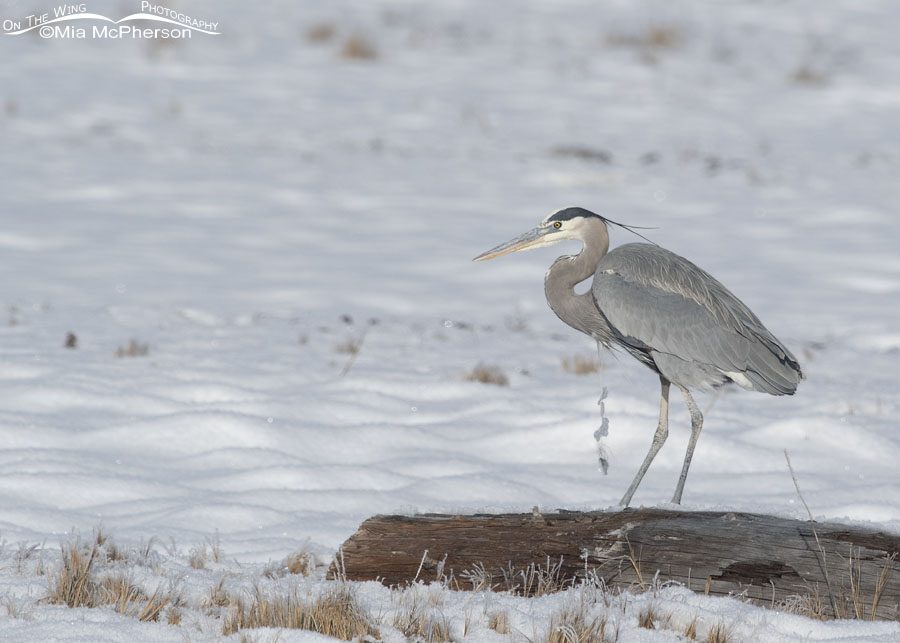 Winter Great Blue Heron with icy feathers hanging from its chest – Nikon D500, f7.1, 1/5000, ISO 500, Nikkor 500mm VR with 1.4x TC, natural light
Winter Great Blue Heron with icy feathers hanging from its chest – Nikon D500, f7.1, 1/5000, ISO 500, Nikkor 500mm VR with 1.4x TC, natural light
The Great Blue Heron had icy feathers hanging from its chest by a thin feather plume. The gray feathers can be seen hanging in front of the legs of the heron.
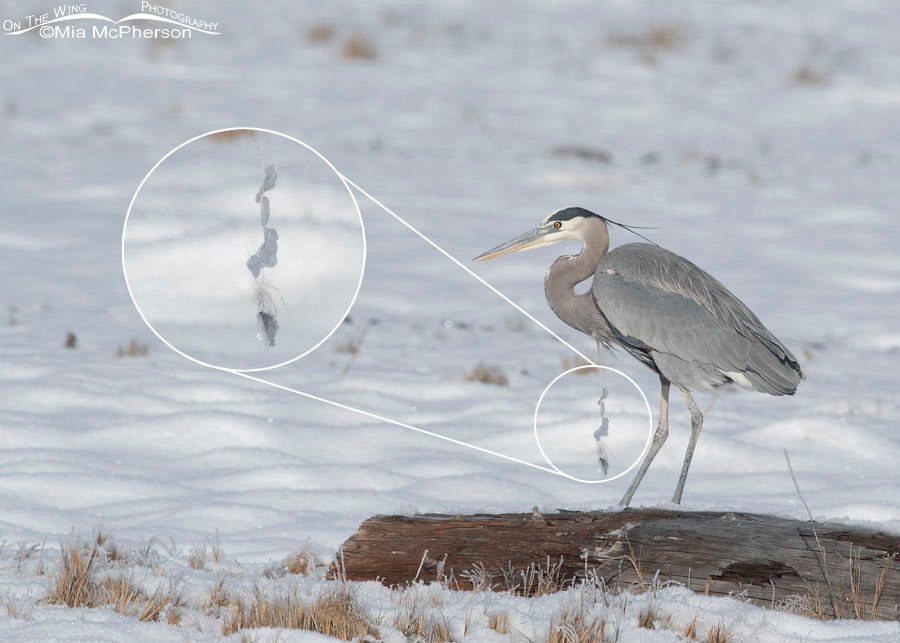 Winter Great Blue Heron with icy feathers hanging from its chest – Inset – Nikon D500, f7.1, 1/5000, ISO 500, Nikkor 500mm VR with 1.4x TC, natural light
Winter Great Blue Heron with icy feathers hanging from its chest – Inset – Nikon D500, f7.1, 1/5000, ISO 500, Nikkor 500mm VR with 1.4x TC, natural light
I’ve added an inset to show a larger version of the icy feathers to this image. In the past I have photographed other Great Blue Herons with large chunks of ice hanging from their chest.
Great Blue Herons will often spend the cold winter nights roosting in shallow water for safety from land predators. There are times during those bitter nights that ice will form on the chest feathers. I photographed a Great Blue Heron in December of 2013 that had ice on its chest that probably weighed more than the heron did. I wasn’t sure that heron could fly with that chunk of ice stuck to it.
The ice on this heron’s chest didn’t prevent it from flying and I am sure it could also hunt and catch food.
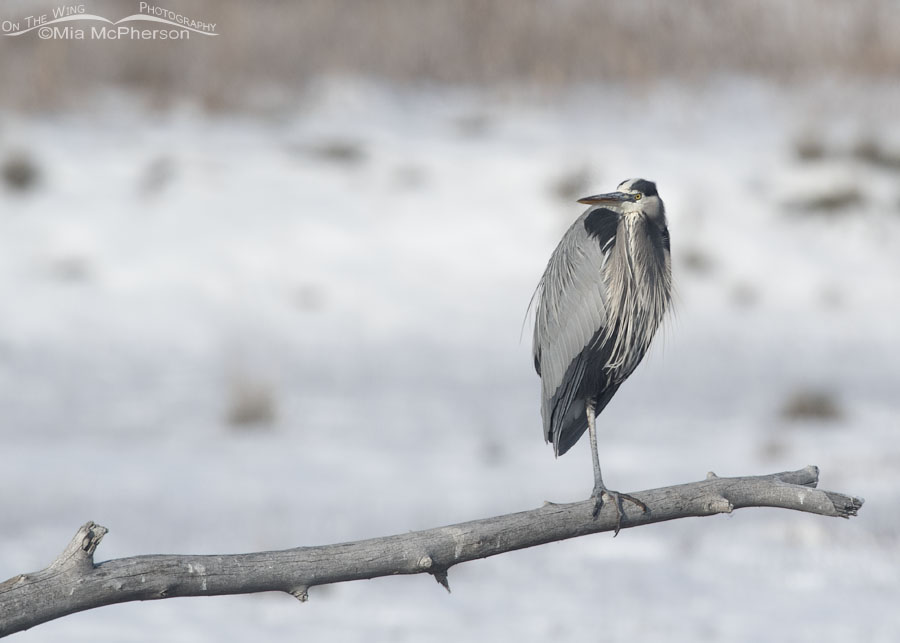 Winter Great Blue Heron perched on a snag in the Bear River – Nikon D500, f7.1, 1/4000, ISO 500, +0.3 EV, Nikkor 500mm VR with 1.4x TC, natural light
Winter Great Blue Heron perched on a snag in the Bear River – Nikon D500, f7.1, 1/4000, ISO 500, +0.3 EV, Nikkor 500mm VR with 1.4x TC, natural light
Not far up the road from the first Great Blue Heron I spotted another Great Blue perched on a snag in the Bear River and stopped to photograph it. This heron didn’t have ice stuck to its chest feathers.
On another recent trip to the refuge I photographed a Ring-billed Gull on this same snag.
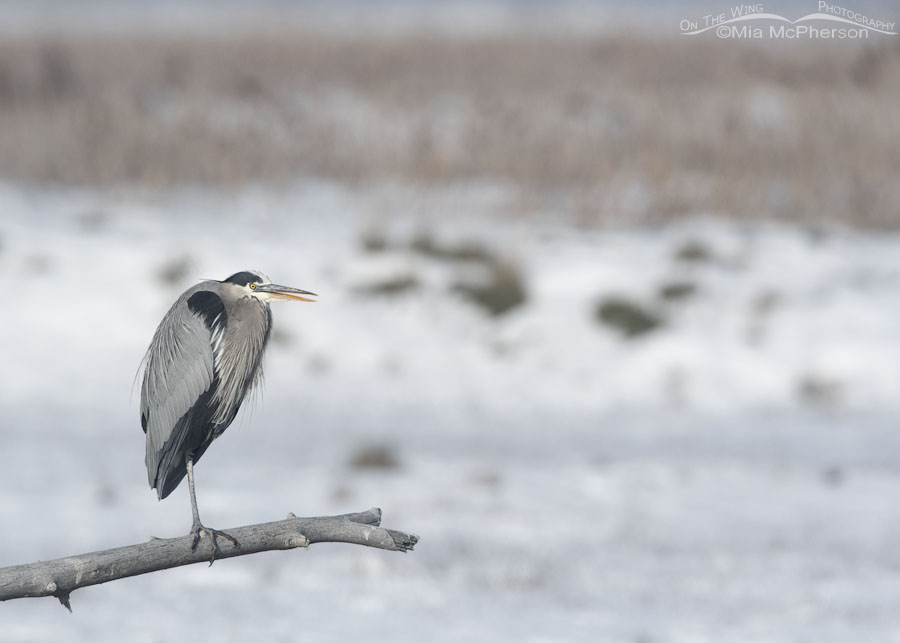 Great Blue Heron in winter perched over the Bear River – Nikon D500, f7.1, 1/4000, ISO 500, +0.3 EV, Nikkor 500mm VR with 1.4x TC, natural light
Great Blue Heron in winter perched over the Bear River – Nikon D500, f7.1, 1/4000, ISO 500, +0.3 EV, Nikkor 500mm VR with 1.4x TC, natural light
The second heron didn’t do much at all while I was with it but one time it opened its bill and I took a photo of it then.
It was foggy in some areas of the auto tour route yesterday morning at the refuge but not nearly as foggy as it had been on my last trip up there. I was happy that it was clear and bright when I photographed these two herons.
Life is good.
Mia
Click here to see more of my Great Blue Heron photos plus facts and information about this species.





Blue herons are such graceful elegant birds. I love this series of shots. Thanks Mia.
I love that landing shot with wings spread!
THANK YOU for sharing a wonder year of photos with us!
Merry Christmas! Enjoy! Be happy/safe/healthy!
It seems so strange to see the Great Blue Heron in snow with icicles hanging from it’s chest. I’ve seen them in South Florida for so many years. Magnificent bird! And a nice series. Maybe they should consider flying south for the winter! Lol…
Beautiful series
Love how the snow provides a very clean background which allows the heron to stand out so well. I am sorry though for the suffering those cold temps must have put your GBH through. Good of you to notice the ice on the poor bird’s chest feathers.
Gorgeous photos! The level of detail you’re able to show is amazing. I love them
How fascinating. The iced up feathers make sense but is not something I had ever considered. Thank you for continuiing my education.
I am glad there was not fog again after the long drive. The second image the ice looks like a dead baby bird hanging. It has a head shape, eye, beak and wing stub.
Love those photos. Wonderful. Such a beautiful bird. Merry Christmas to you.
This hero looks so strangely human this morning of frozen rain, or that we as a species are so heron like. Thank you for the images you bring!
Beautiful photos